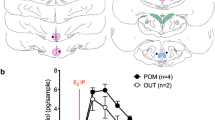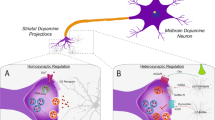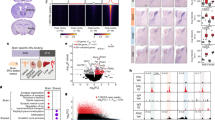Abstract
The steroid anaesthetic Althesin (Glaxo), which is a mixture of two C21 steroids, alphaxalone (3α-hydroxy-5α-pregnane-11, 20-dione—the active compound) and alphadolone acetate (21-acetoxy-3α-hydroxy-5αpregnane-11, 20-dione), has been especially useful for the study of forebrain-autonomic1 and neuroendocrine functions2–5. As determined by the loss of the righting reflex, Child et al.6 found no sex difference in the anaesthetic dose of Althesin administered intravenously (i.v.). However, in our neuroendocrine studies2–5 in which the anaesthetic was adminstered intraperitoneally (i.p.) and at dosage sufficient to produce surgical anaesthesia and analgesia, we observed a sex difference in the efficacy of Althesin. This may explain the difficulties that have been encountered in obtaining adequate anaesthesia (blockade of the somatomotor response to pain) with Althesin. Here we report, using cortical electroencephalography, that Althesin is a more potent anaesthetic than either sodium pentobarbitone or urethane, and that anaesthesia in the male rat requires about four times more Althesin (administered i.p.) than in the female. This sex difference is age dependent, can be abolished by administering oestrogen to the male, does not depend on sexual differentiation of the brain, and cannot be attributed to a sex difference in the metabolic clearance rate of alphaxalone. These results, taken together with those of Richards and Hesketh7, suggest that the effect of alphaxalone may be mediated by interactions with synaptic membranes that are more specific than simply a generalized change in membrane structure, and that these interactions are affected by sex steroids.
This is a preview of subscription content, access via your institution
Access options
Subscribe to this journal
Receive 51 print issues and online access
$199.00 per year
only $3.90 per issue
Buy this article
- Purchase on Springer Link
- Instant access to full article PDF
Prices may be subject to local taxes which are calculated during checkout
Similar content being viewed by others
References
Timms, R. J. J. Physiol., Lond. 256, 70–71 (1976).
Sarkar, D. K., Chiappa, S. A., Fink, G. & Sherwood, N. M. Nature 264, 461–463 (1976).
Sarkar, D. K. & Fink, G. J. Endocr. 80, 303–313 (1979).
Sarkar, D. K. & Fink, G. J. Endocr. 83, 339–354 (1979).
Sherwood, N. M., Chiappa, S. A., Sarkar, D. K. & Fink, G. Endocrinology 107, 1410–1417 (1980).
Child, K. J. et al. Br. J. Anaesth. 43, 2–13 (1971).
Richards, C. D. & Hesketh, T. R. Nature 256, 179–182 (1975).
Pickerodt, V., McDowall, D. G., Coroneos, N. J. & Keaney, N. P. Postgrad. med. J. 48, Suppl. 2, 58–60 (1972).
Scott, D. F. & Virden, S. Postgrad. med. J. 48, Suppl. 2, 93–96 (1972).
Takahashi, T. Postgrad. med. J. 48, Suppl. 2, 96–103 (1972).
Harris, G. W. Phil. Trans. R. Soc. B259, 167–177 (1970).
Brown-Grant, K. in Foetal and Neonatal Physiology (eds Comline, K. S., Cross, K. W., Dawes, G. S. & Nathanielz, P. W.) 527–545 (Cambridge University Press, Cambridge, 1973).
VuHai, M. T. & Milgrom, E. J. Endocr. 76, 21–31 (1978).
MacLusky, N. J. & McEwen, B. S. Nature 274, 276–278 (1978).
Henderson, S. R., Baker, C. & Fink, G. J. Endocr. 73, 441–453 (1977).
Holly, J. M. P., Trafford, D. J. H., Sear, J. W. & Makin, H. L. J. J. Pharm. Pharmac. 33, 427–433 (1981).
Child, K. J., Gibson, W., Harnby, G. & Hart, J. W. Postgrad. med. J. 48, Suppl. 2, 37–43 (1972).
Dow, R. C., McQueen, J. K. & Townsend, H. R. D. Epilepsia 13, 459–465 (1972).
Author information
Authors and Affiliations
Rights and permissions
About this article
Cite this article
Fink, G., Sarkar, D., Dow, R. et al. Sex difference in response to alphaxalone anaesthesia may be oestrogen dependent. Nature 298, 270–272 (1982). https://doi.org/10.1038/298270a0
Received:
Accepted:
Issue Date:
DOI: https://doi.org/10.1038/298270a0
This article is cited by
-
Estrogen Receptor-A in Medial Preoptic Area Contributes to Sex Difference of Mice in Response to Sevoflurane Anesthesia
Neuroscience Bulletin (2022)
-
From the Stalk to Down Under about Brain Glucocorticoid Receptors, Stress and Development
Neurochemical Research (2008)
Comments
By submitting a comment you agree to abide by our Terms and Community Guidelines. If you find something abusive or that does not comply with our terms or guidelines please flag it as inappropriate.



